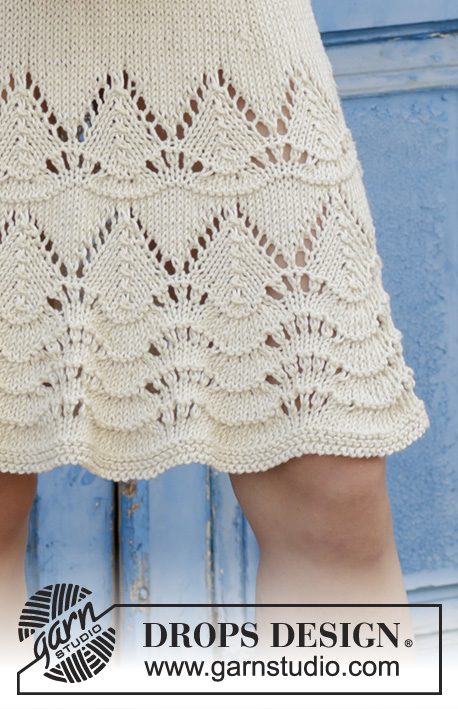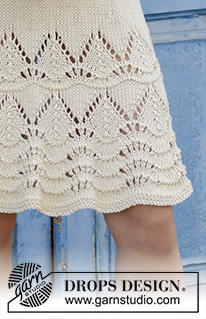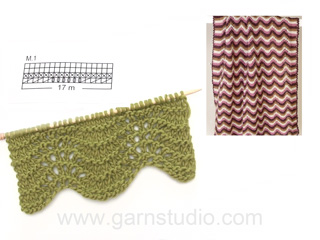Love Letter |
||||||||||||||||||||||||||||
 |
 |
|||||||||||||||||||||||||||
Knitted dress with lace pattern. Size: S - XXXL Piece is knitted in DROPS Paris.
DROPS 188-31 |
||||||||||||||||||||||||||||
|
INFORMATION FOR PATTERN: GARTER STITCH (worked in the round): 1 ridge = 2 rounds. Knit 1 round and purl 1 round. GARTER STITCH (back and forth): 1 ridge = knit 2 rows. PATTERN: See diagrams A.1 to A.3. Choose diagram for your size (applies to A.3). Diagrams show all rows in pattern seen from the right side. MEASURING TIP: When working wave pattern, the piece will curl in bottom edge. All length measurements are done from where curl is shortest. DECREASE TIP-1 (applies to skirt part on dress): Decrease as follows after marker thread: Slip 1 stitch knitwise, knit 1, pass slipped stitch over stitch worked (= 1 stitch decreased). Decrease as follows before marker thread: Begin 2 stitches before marker thread, knit 2 together (= 1 stitch decreased). DECREASE TIP-2 (applies to armholes): All decreases are done from the right side. Decrease inside 3 edge stitches in garter stitch. Decrease after 3 edge stitches as follows: Slip 1 stitch knitwise, knit 1, pass slipped stitch over (= 1 stitch decreased). Decrease before 3 edge stitches as follows: Begin 2 stitches before the 3 edge stitches and knit 2 together (= 1 stitch decreased). DECREASE TIP-3: To calculate how to decrease evenly, use the total number of stitches on row (e.g. 180 stitches) and divide stitches by number of decreases to be done (e.g. 8) = 22.5. In this example work alternately every 21st and 22nd stitch and every 22nd and 23rd stitch together. INCREASE TIP (applies to sides of dress): All increases are done from the right side! Increase on each side of marker thread in the sides on dress as follows: Work until 2 stitches remain before marker, make 1 yarn over, knit 4 (marker thread is in the middle of these 4 stitches), make 1 yarn over (= 2 stitches increased). On next row/round work yarn overs twisted to avoid holes. ---------------------------------------------------------- DRESS: Work in the round on circular needle from bottom edge and up until vent begins mid front, then work piece back and forth from mid front. After decrease for armholes work front and back piece back and forth separately. SKIRT: Cast on somewhat loosely 247-266-285-323-342-380 stitches on circular needle size 5 mm with Paris. Work 2 ridges in GARTER STITCH in the round - see explanation above. Then work A.1 (= 13-14-15-17-18-20 repetitions of 19 stitches). REMEMBER THE KNITTING TENSION! NOTE! On round marked with arrow-1 in A.1 displace beginning of round 2 stitches to the left to make the pattern fit. On round marked with arrow-2 in A.1 displace beginning of round 1 stitch to the left. When A.1 has been worked, there are 156-168-180-204-216-240 stitches on needle. Then work in stocking stitch. When piece measures 28 cm - read MEASURING TIP, insert 4 marker threads in piece as follows: Insert 1st marker thread after the first 18-21-24-30-32-38 stitches, insert 2nd marker thread after the next 42-42-42-42-44-44 stitches, insert 3rd marker thread after the next 36-42-48-60-64-76 stitches and insert 4th marker thread after the next 42-42-42-42-44-44 stitches. 18-21-24-30-32-38 stitches remain on round after last marker thread. Move marker threads upwards when working. On next round, decrease after 1st and 3rd marker thread and before 2nd and 4th marker thread – read DECREASE TIP-1 (= 4 stitches decreased). Decrease like this every 4½-4½-5½-5½-6-6 cm 7-7-6-6-6-6 times in total at every marker thread = 128-140-156-180-192-216 stitches. Remove all marker threads. When piece measures 59-60-61-62-63-64 cm (decreases are now done), knit 1 round while decreasing 0-0-0-8-0-4 stitches evenly = 128-140-156-172-192-212 stitches. Switch to circular needle size 4 mm and work A.2 in the round. When A.2 has been done, insert 1 marker thread at the beginning of round (= in the side), insert 1 marker after 32-35-39-43-48-53 stitches (= mid front) and 1 marker thread after 32-35-39-43-48-53 stitches (= in the side), there are 64-70-78-86-96-106 stitches between marker threads on back piece. Switch back to circular needle size 5 mm. Cut the yarn. Now work piece back and forth on circular needle from marker mid front. Begin first row from right side at marker mid front and work as follows: A.3B (= 12-12-14-14-16-16 stitches), 40-46-50-58-64-74 stitches in stocking stitch (marker thread in the side is in the middle of these 40-46-50-58-64-74 stitches), work A.3A (= 12-12-14-14-16-16 stitches), A.3B (= 12-12-14-14-16-16 stitches), 40-46-50-58-64-74 stitches in stocking stitch (marker thread in the side is in the middle of these 40-46-50-58-64-74 stitches) and finish with A.3A (= 12-12-14-14-16-16 stitches). Continue pattern back and forth like this. When piece measures 3 cm from division, increase 1 stitch on each side of marker threads in the sides - read INCREASE TIP (= 4 stitches increased). Repeat increase when piece measures 8-8-9-9-10-10 cm from division = 136-148-164-180-200-220 stitches. When piece measures 73-75-77-79-81-83 cm, work 2 ridges over the middle 12-12-14-18-22-26 stitches in each side (i.e. work 6-6-7-9-11-13 stitches in garter stitch on each side of both marker threads – work the other stitches as before). On first row from right side after ridges cast off 6-6-8-12-16-20 stitches in each side for armholes (cast off 3-3-4-6-8-10 stitches on each side of both marker threads). Finish front pieces and back piece separately. LEFT FRONT PIECE (when garment is worn): = 31-34-37-39-42-45 stitches. Continue back and forth with A.3A towards mid front, stocking stitch and 3 edge stitches in garter stitch towards armhole (work first row from wrong side). When 3 rows have been worked back and forth, decrease for armhole on next row from right side - read DECREASE TIP-2. Decrease like this on every other row (i.e. every row from right side) 2-3-5-6-8-11 times in total = 29-31-32-33-34-34 stitches. Continue pattern back and forth as before with 3 edge stitches in garter stitch towards armhole, stocking stitch and A.3A towards mid front until piece measures approx. 84-87-90-93-96-99 cm (adjust so that next row is worked from wrong side and adjust to finish after one whole repetition vertically if possible). Now slip the first 7-8-8-9-10-10 stitches on 1 stitch holder for neck but to avoid cutting the yarn work them before slipping them on the stitch holder. Continue to cast off for neck at beginning of every row from mid front (i.e. at beginning of each row from wrong side) as follows: Cast off 2 stitches 2 times and 1 stitch 3 times = 15-16-17-17-17-17 stitches remain on shoulder. Work until 1 row remains before piece measures 90-93-96-99-102-105 cm, knit 1 row from wrong side and cast off by knitting from right side. RIGHT FRONT PIECE: = 31-34-37-39-42-45 stitches. Continue back and forth with 3 edge stitches in garter stitch towards armhole, stocking stitch and A.3B towards mid front (work first row from wrong side). When 3 rows have been worked back and forth, decrease for armhole on next row from right side - read DECREASE TIP-2. Decrease like this on every other row (i.e. every row from right side) 2-3-5-6-8-11 times in total = 29-31-32-33-34-34 stitches. Continue pattern back and forth as before with A.3B towards mid front, stocking stitch and 3 edge stitches in garter stitch towards armhole until piece measures approx. 84-87-90-93-96-99 cm (adjust so that next row is worked from right side and finish on the same row in A.3 as on left front piece). Now slip the first 7-8-8-9-10-10 stitches on 1 stitch holder for neck but to avoid cutting the yarn work them before slipping them on the stitch holder. Continue to cast off for neck at beginning of every row from mid front (i.e. at beginning of each row from right side) as follows: Cast off 2 stitches 2 times and 1 stitch 3 times = 15-16-17-17-17-17 stitches remain on shoulder. Work until 1 row remains until piece measures 90-93-96-99-102-105 cm, knit 1 row from wrong side and cast off by knitting from right side. BACK PIECE: = 62-68-74-78-84-90 stitches. Continue back and forth with 3 edge stitches in garter stitch in each side, stocking stitch and A.3A/A.3B mid back (work first row from wrong side). When 3 rows have been worked back and forth, decrease for armhole in each side on next row from right side - read DECREASE TIP-2 (= 2 stitches decreased). Decrease like this on every other row (i.e. every row from right side) 2-3-5-6-8-11 times in total = 58-62-64-66-68-68 stitches. Continue pattern back and forth as before with A.3A/A.3B mid back, stocking stitch and 3 edge stitches in garter stitch in each side towards armholes until piece measures 88-91-94-97-100-103 cm. Now cast off the middle 26-28-28-30-32-32 stitches for neck and finish each shoulder separately. Continue as before over shoulder stitches and cast off 1 stitch for neck on next row from the neck = 15-16-17-17-17-17 stitches remain on shoulder. Work until 1 row remains until piece measures 90-93-96-99-102-105 cm, knit 1 row from wrong side and cast off by knitting from right side. Work the other shoulder the same way. ASSEMBLY: Sew the shoulder seams. Sew the opening at the mid front, start at the bottom and sew up until 10 cm remain before the neckline (or desired length) – sew in the outermost loop of the outermost stitch so that the seam is flat. NECK EDGE: Begin mid front and pick up from right side approx. 72 to 88 stitches around the neck (including stitches on stitch holders at the front) on circular needle size 4 mm. Knit 1 row from wrong side, knit 1 row from right side and knit 1 row from wrong side. Cast off knitting from right side. TWINED STRING: Cut 2 strands Paris of 3 metres each. Twine the strands tog until they resist, fold the string double so that it twines again. Make a knot at each end. Fasten a small wooden bead in each end of the tie. Make 2 tassels and fasten one tassel in each end of string, under wooden bead in each side. 1 tassel = cut 12 strands Paris of 11 cm each. Cut 1 strand of approx. 25 cm to fasten tassel with and place this strand in the middle of the 12 strands. Fold the thread double and tie a new thread around the tassel (approx. 1 cm from the top), fasten tightly and sew tassel to string as explained below. Make the other tassel the same way. Place string with tassels double and thread loop through a stitch at the top of vent at the front on dress, pull string ends through loop. Make a similar string with wooden beads and tassels and fasten it at the top of vent on the other side. |
||||||||||||||||||||||||||||
Diagram explanations |
||||||||||||||||||||||||||||
|
||||||||||||||||||||||||||||

|
||||||||||||||||||||||||||||

|
||||||||||||||||||||||||||||

|
||||||||||||||||||||||||||||

|
||||||||||||||||||||||||||||
|
Have you made this or any other of our designs? Tag your pictures in social media with #dropsdesign so we can see them! Do you need help with this pattern?You'll find tutorial videos, a Comments/Questions area and more by visiting the pattern on garnstudio.com. © 1982-2024 DROPS Design A/S. We reserve all rights. This document, including all its sub-sections, has copyrights. Read more about what you can do with our patterns at the bottom of each pattern on our site. |
||||||||||||||||||||||||||||









































































Comments / Questions (20)
Hei, en saa kuviota täsmäämään\r\nkuviossa A1, rivistä 29 eteenpäin, vaikka olen siirtänyt aloituskohtaa kaksi merkkiä vasemmalle.Mitä pitäisi tehdä?
12.03.2023 - 15:13Robię tę sukienkę i utknęłam na rzędzie 27. Robię 5 oczek prawych, podwójny narzut, oczko prawe, podwójny narzut, 5oczek prawych, przekładam 1 oczko na prawy drut, przerabiam 3 oczka razem i przekładam oczko zdjęte ponad oczkami przerobionymi razem. Wzoru powinny być zamknięte 2 oczka, żeby pozostało 15 oczek na motyw, z moich obliczeń wynika, że zamykam 3 oczka, więc zostaje mi 14 oczek na motyw... Co robię źle? 21.09.2022 - 19:50
22.09.2022 - 09:51DROPS Design answered:
Witaj Magdo, wyjściowo masz 15 oczek na każdy motyw zanim zaczniesz przerabiać rząd 27. Po przerobieniu rz. 27 będziesz miała o 1 oczko mniej w każdym motywie, czyli 14 oczek > dodasz 2 oczka wykonując narzuty i zamkniesz 3 oczka (+2-3 = -1). Tak więc po przerobieniu rz. 27 zostanie Ci 14 oczek na każdy motyw, czyli dokładnie jak u Ciebie. Powodzenia!
22.09.2022 - 11:50Guten Tag, für die Vorderteile soll laut Anleitung 3 Reihen hin- und zurückgestrickt werden, dann für den Armausschnitt in der nächsten Hin-Reihe abnehmen. Ist damit gemeint, dass jeweils 3 Reihen hin und 3 Reihen rück gestrickt werden soll oder soll insg. 3 Reihen gestrickt werden bis zum Abnehmen? Danke für die Hilfe!
06.03.2022 - 10:28DROPS Design answered:
Liebe Isabel, es sind insgesamt 3 Reihen gemeint. Viel Spaß beim stricken!
07.03.2022 - 08:59Bonjour, vous avez toujours des beaux modèles mais malheureusement, il me faut me contenter chaque fois du dessin du patron parce que vous ne mettez plus que des tricots faits avec les aiguilles circulaires. c'est pour ça que je ne peut essayer vos laine, mes machines à tricoter ne se prêtant pas volontiers au tricots circulaire. Je suis triste de ne plus comme avant tricoter vos propositions !
13.12.2021 - 12:52DROPS Design answered:
Bonjour Mme Debay, peut-être que cette leçon pourrait vous donner quelques pistes pour adapter nos explications sur des aiguilles droites/machine à tricoter?
14.12.2021 - 07:57I A1 er det pil 1 og 2. Hvordan forskyver jeg disse maskene? Har prøvd, men blir feil. Et eller annet jeg ikke forstår.
09.07.2021 - 23:03DROPS Design answered:
Hej Therese, jo hvis du sørger for at de 2 midterste kast havner lige over de 2 midterste kast fra tidligere pinde, så vil du få 5 retmasker på hver side af omslagene ved pil 1 og 4 retmasker ved pil 2. God fornøjelse!
13.07.2021 - 14:513 st kantmaskor vid ärmhålan, hur ska jag göra de?
20.04.2021 - 18:17DROPS Design answered:
Hej Tina. Du stickar 3 kantmaskor i rätstickning, dvs du stickar de räta på varje varv när du stickar fram och tillbaka. Mvh DROPS Design
21.04.2021 - 07:10Miia, ihmettelin itse samaa, katso englanninkielinen ohje, siinä on kerrottu että aukko ommellaan lopuksi kiinni.
18.07.2020 - 14:00Miksi mekko neulotaan tasona A.2 kuvion jälkeen? Kuvassa näyttää siltä että halkion alku on ommeltu kiinni jonkin matkaa. Senhän olisi voinut pyörönä jatkaa vielä ylemmäs? Lisäksi halkion ompelusta ei ole mainintaa, mutta eihän se voi auki jäädä noin alas?
04.06.2020 - 00:15Since there is no picture of the back of the dress I'd like to clarify if we need to knit A3B and A3A on the back. From what I'm reading in the instructions I understand that we do. I just need to check if I'm reading it right. Thank you.
24.04.2020 - 09:33DROPS Design answered:
Dear Mrs Ribeiro, yes you will work A.3A and A.3B in the back of piece, as explained in the written pattern. Happy knitting!
24.04.2020 - 09:45Där det står pil 1 i mönster A1 förkjuter jag mönstret två maskor. Ska man göra det varje varv efter det. Får det inte att bli ett "hål V" annars.
27.03.2020 - 09:53DROPS Design answered:
Hej Sofia, du skal ikke forskyde maskerne yderligere, men når du har forskudt en gang, starter du nu diagrammet hver for hver gang. Sørg for at du får 2 masker mere imellem hvert omslag og strik de 3 masker sammen over hinanden hver gang. God fornøjelse!
31.03.2020 - 11:14